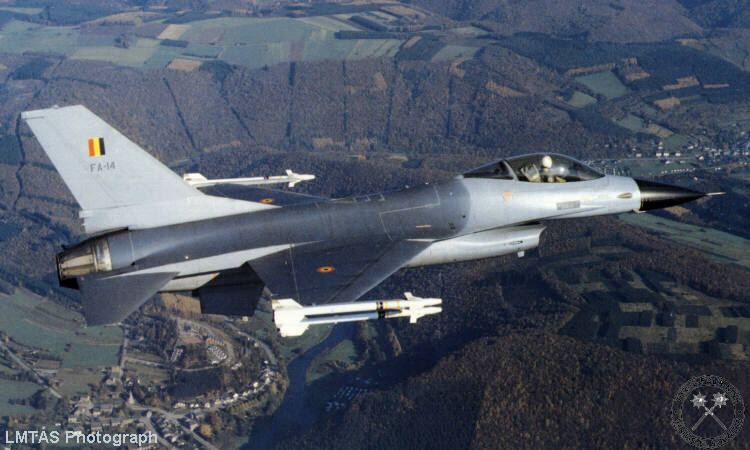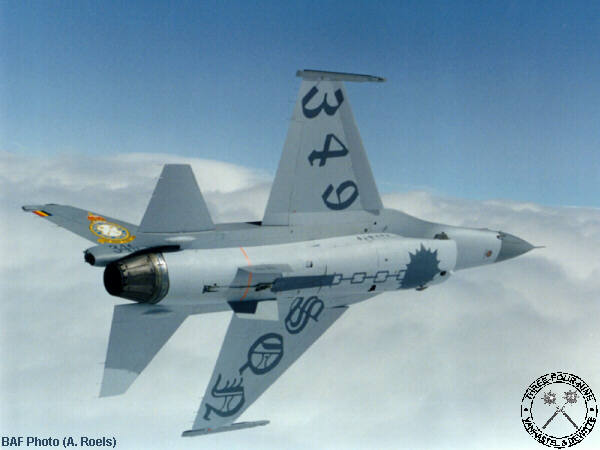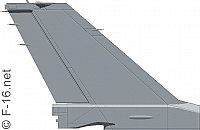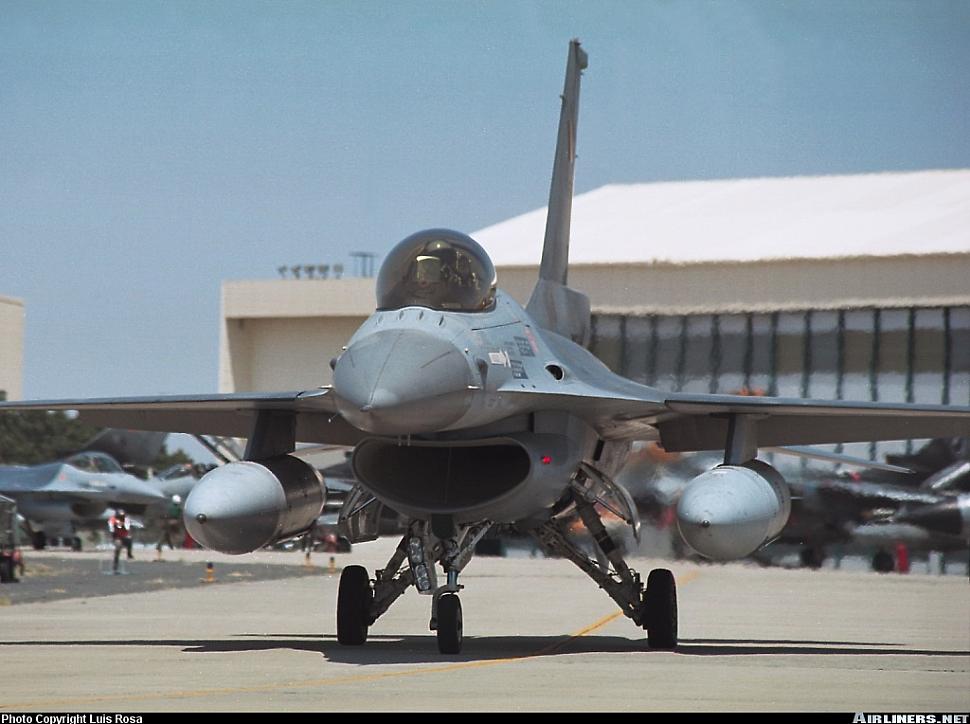History
The F-16A/B was the first production version of the Fighting Falcon, the A being the single-seat version and the B being the two-seat version. Aside from the second seat, the A and B versions are essentially identical and have the same performance envelope and armament fit.
Unfortunately, The USAF decided not to use the tried-and-true shorthand for describing minor changes to the Fighting Falcon that are introduced on the production line. Instead, F-16s are referred to by a rather bewildering set of Block Numbers, MSIP stages, and OCU's. The acronym MSIP stands for "Multinational Staged Improvement Program", and is a blanket name for a program in which changes are incorporated in the F-16s as they come off the production line, rather than marrying them to a Multi-Stage Improvement Program, as was done for the F-15 Eagle. The acronyms are the same, but the way that the two programs work is quite different.
block 1

The two YF-16s and the eight FSD F-16A's were immediately followed by the first operational F-16s, designated Block 1. The first F-16A Block 1, #78-0001, made its maiden flight in August 1978, and was delivered to the USAF in that same month. It was assigned to the 388th Tactical Fighter Wing at Hill AFB, Utah. A total of 94 Block 1 aircraft rolled off the production line at the Fort Worth facility; they were all delivered to the USAF and the 4 initial European customers (Belgium, Denmark, The Netherlands and Norway). Block 1 F-16s (and the FSD aircraft) can be distinguished from all subsequent Fighting Falcons by a black radome. Between late-1981 and mid-1984 however, these aircraft were brought up to block 10 standard under projects Pacer Loft I (starting 1982) and Pacer Loft II (1983). These upgrades involved the graying of the radomes. Block 1 (and block 5, 10) aircraft originally had a small horizontal tailplane and a single UHF blade antenna under the air intake. The larger tail was retrofitted later.
Block 5

Pilots flying the early Block 1 F-16A's complained that the black radome stuck out like a sore thumb during simulated air-to-air combat and made it easy for the enemy to visually acquire the F-16. On Block 5, the gray radome was introduced, which became standard for all later Fighting Falcons. The Block 5 production batch totaled 197 aircraft. These aircraft were also upgraded to Block 10 specifications under Pacer Loft I and II. Block 5 F-16s have the same blade UHF antenna under the intake as the Block 1, as well as the small stabilator. Differences with the Block 1 are inconspicuous, involving modifications to improve reliability and mission-ready rate.
Block 10
312 Block 10 aircraft were build through 1980. The F-16s still had the blade UHF aerial and small tail. Differences with Block 5 aircraft are again internal improvements with no apparent external modifications. Some USAF Block 10 aircraft were later (1987-1993) retrofitted to block 15OCU standard. 24 F-16A/B Block 10 aircraft from the New York ANG were briefly modified to carry the GPU-5/A 30mm gun pod (see CAS F-16s). After seeing limited service in Operation Desert Storm, the were converted back to 'normal' Block 10 aircraft.
block 15

In November 1981, the Block 15 introduced MSIP Stage I changes to the F-16A/B starting with subblock 15Y and continuing through subblock 15AZ. More than a year earlier, in February 1980, these modifications were already effective on the F-16C/D production. The changes expanded the F-16s growth potential by allowing improved capabilities in the air-to-ground and BVR missions.
One major modification was the addition of two hardpoints to (and structural strengthening of) the chin of the inlet, designated hardpoints 5L and 5R. To offset the shift in center of gravity caused by the weight of these two additional hardpoints (and eventual stores attached to them), the extended horizontal stabilator (the so-called "big tail", 30% increase in area), was fitted. The new tail also provided better stability and more authority for out-of-control situations. It changed lift-off rotation speeds and allowed stable flight at higher angles of attack.
The AN/APG-66 radar on the Block 15 Fighting Falcons was provided with an early version of a track-while-scan mode for greater air defense capability. The F-16s were also equipped with Have Quick I secure UHF radios, and internal provisions for the AIM-7 were made. Additional structural strengthening was performed to allow an extra 1000 pounds of ordnance to be carried on the underwing points. Last but not least, pilot comfort was enhanced by improving the cockpit air conditioning.
The production run of the Block 15, saw 983 aircraft produced over a 14 year time-span, and took place on 3 production lines. The first Block 15 F-16 (#80-0541, the 330th F-16 built) rolled out in 1982. In 1996, the last block 15 was delivered to Thailand, the 11th Block 15 customer. Early USAF Block 15 aircraft were later (1987-1993) retrofitted to Block 15OCU specifications.
Block 15OCU
214 aircraft from Block 15Y onwards received upgraded systems starting late-1987. Designated Block 15OCU (Operational Capability Upgrade), these aircraft are powered by the more reliable F100-PW-220 turbofan. These aircraft also have structural strengthening and are provided with the enlarged HUD that was first introduced on the F-16C/D. Also incorporated are the capability to fire the Norwegian Penguin Mk.3 anti-shipping missile (built by Kongsberg, US designation AGM-119) and the AGM-65, provisions for the AIM-120 AMRAAM, radar altimeter, expanded computer capacity, data transfer unit, wide-angle HUD, AN/APX-101 IFF, Tracor AN/ALE-40 chaff/flare dispenser and provisions for the AN/ALQ-131 ECM pod. These modifications increased the max. TO weight to 37,500lbs (17,010kg). The first Block 15OCU was delivered in January 1988, and from 1988 onwards, all Block 15's were built to OCU specifications.
Block 20
The 150 F-16A/B Block 15OCU's for Taiwan are built to MLU standards and are designated Block 20. The Block 20 designation was reserved in the 1980's. It was later assigned to the Taiwanese aircraft and to the MLU program initiated to bring the European F-16s to an enhanced level, comparable with the block 50 F-16s of the USAF.
Structure & Avionics
The early versions of the F-16 Fighting Falcon were equipped with a comprehensive avionics suite, involving a Westinghouse AN/APG-66 pulse-Doppler fire-control radar, a Singer-Kearfott SKN-2400 INS, UHV/VHF comms suite, ILS, TACAN, a Dalmo Victor AN/ALR-69 RWR, GEC Marconi Avionics HUD and a Sperry central air data computer. The F-16A/B was initially powered by the F100-PW-200 turbofan, rated at 12,240 lb.s.t. dry, 14,670 lb.s.t. full military, and 23,830 lb.s.t. with afterburning. Production F-16s have the standard ACES II ejection seats.
Later, more advanced avionic packs were installed in these early production aircraft. These included upgraded AN/APG-66 radar sets, AN/ALR-74 RWR and F100-PW-220 engine with digital control interface.
Modifications & Upgrades
As mentioned before, Pacer Loft I & II saw the Block 1 and 5 models upgraded to Block 10 standard.
Between late-1987 and late-1993, some USAF Block 10 and early Block 15 aircraft were upgraded to Block 15OCU standard.
Between 1991 and 1996, earlier models of the F-16 with the -200 engines had them upgraded to -220E standard, providing capabilities and lifespan comparable to the Block 15OCU -220 engine.
From 1994, British Aerospace Systems & Equipment TERPROM (Terrain Profile Matching) software was installed in ANG and AFRES F-16s. TERPROM minimalizes the ground collision danger.
In October 1986, the USAF decided that remaining F-16A's would be modified as Air Defence Fighters (F-16 ADF) for the Air National Guard.
The four original European customers of the F-16 are now upgrading their F-16 Block 15's in the MLU program, whilst several other countries are also considering this upgrade.
Other upgrades are provided by Israel and Singapore, who developed their own upgrade programs for earlier F-16 models. These upgrade programs are called respectively 'ACE' (Avionics Capabilities Enhancement) and 'Falcon One'. So far, no customers are found for these two programs.
Since 1988, all Foreign Military Sales (FMS) aircraft received some features of the F-16C/D, including a RLG (Ring Laser Gyro)/INS, AN-ALR-69 RWR, the -220 engine and provisions for the AIM-9P-4 Sidewinder.
Production
Production for the USAF totaled 674 F-16A's and 121 F-16B's, and was completed in March 1985. Of these two F-16A's (#82-0966, #82-0974) were built by Fokker and four F-16B's (#82-1031, #82-1035, #82-1036, #82-1039) were built by SABCA. The remainder were built by Fort Worth.
Fort Worth built 67 F-16A's for Israel, 39 for Egypt, 28 for Pakistan, plus a second batch of 11 which have not yet been delivered, 18 for Venezuela, 8 for Thailand, 4 for Singapore, 8 for Indonesia and 12 for Singapore. Fort Worth also built 8 F-16B's for Israel, 9 for Egypt, 12 for Pakistan (including four built by Fokker), 6 for Venezuela, 4 for Singapore, 4 for Thailand and 4 for Indonesia.
In the initial European order, SABCA built 96 F-16A's for the Belgian Air Force (serials #FA-01 till #FA-96) at Gosselies. The last example was delivered on April 28th, 1985, this aircraft being the final aircraft on the original NATO F-16 order for 348 planes. A second order for 40 (#FA-97 till #FA-136) was completed in 1991. Forty six were built for Denmark (serials #E-174 till #E-203). SABCA built 24 F-16B's for Belgium (serials #FB-01 till #FB-24) and 16 for Denmark (serials #ET-204 till #ET-211, #ET-0197 till #ET-199 and #ET-022).
Fokker built an initial batch of 40 F-16A's for the Netherlands Air Force (serials #J-212 till #J-258 and #J-616 till #J-648). Orders have since been increased to a total of 167 (serials #J-864 till #J-881, #J-358 till #J-367, #J-136 till #J-146, #J-054 till #J-063, #J-508 till #J-514, #J-001 till #J-012 and #J-013 till #J-021). The last 20 on the order were designated F-16A(R) and were capable of carrying an Oude Delft Orpheus sensor pod on the fuselage centerline station. This variant was first flown on January 27th, 1983.
Fokker also built two F-16A's for the USAF, sixty for Norway and an initial batch of 22 F-16B's for the Netherlands (serials #J-259 till #J-271, #J-649 till #J-657) plus at least fourteen more (serials #J-882, #J-884 and #J-885, #J-208 till #J-211, #J-368 and #J-369, #J-064 and #J-065, #J-515 and #J-516). One example was delivered to Egypt and 12 F-16B's were delivered to Norway. Two of the original batch for the Netherlands were completed as F-16B(R) and were capable of carrying the underfuselage Orpheus reconnaissance pod.
Specifications
Engine: One Pratt & Whitney F100-PW-200 turbofan, rated at 12,240 lb.s.t. dry, 14,670 lb.s.t. full military, and 23,830 lb.s.t. with afterburning.
Maximum speed: Mach 2.05 at 40,000 feet. Service ceiling 55,000 feet. Maximum range 2400 miles. Initial climb rate 62,000 feet per minute.
Dimensions: wingspan 32 feet 9 1/2 inches, length 49 feet 3 1/2 inches, height 16 feet 8 1/2 inches, wing area 300 square feet.
Weights: 16,285 pounds empty, 25,281 pounds combat, 37,500 pounds maximum takeoff.
Max TO Gross weight for all USAF/EPAF F-16A/B models is 35,400lbs, although a maximum in flight limit of 37,500lbs may be permitted. This higher GW should not be applied for ground handling, taxiing or take-off as the the light weight landing gear was designed for a maximum GW of 35,400lbs.
Please use this form to add any list any error or omissions you find in the above text.
Note: your comments will be displayed immediately on this page. If you wish to send a private comment to the webmasters, please use the Contact Us link.


